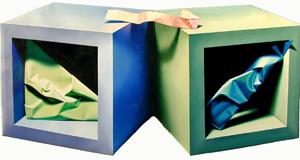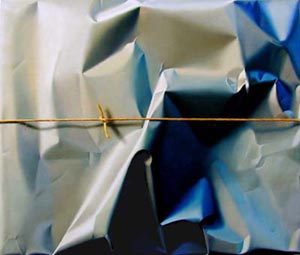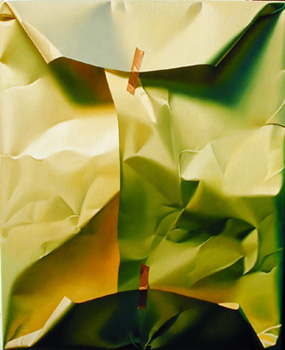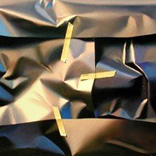To like Yrjo Edelmann’s paintings is to admit you’ve been suckered, but there it is; I like them.
You can sum up the trick in a single line: they look like paintings wrapped in crumpled paper. It’s a good trick; the illusionism is remarkably effective, and gives the paintings a dumb, universal appeal. I want to believe Yrjo Edelmann is tucked away in Stockholm, churning out his highly finished trick paintings, unaware, or unconcerned, with the artworld’s troubles and upheavals over the past 120 years, but it’s not true.
Presumably without meaning to, Edelmann’s work unravels irony. It’s commercial schlock, but neither schlock nor commercialism are black marks in themselves: look at Jeff Koons or Mark Kostabi. Edelmann’s paintings engage all the right issues: they can be read as a critique of formalist abstraction, decorative ambient pop, or a comment on commodification; what they lack is that ironic sense of their own schlockiness which would make it all OK. Painted with a humorless, mechanical precision, Edelmann’s paintings really are the pretty, vacant kitsch that Koons and Kostabi satirize from a safe distance. Despite strenuous efforts by artists and critics, high is still high, and low is still low, and there’s nothing in between.
There’s no point in having a roomful of Edelmanns; they’re all the same. By the second painting, the surprise is gone. The gallery is merely a depot from which these paintings will be distributed one at a time to homes and offices where they will be more effective. In fact, the three paintings which aren’t the same are much worse. Lacking the boneheaded simplicity of the wrapped-painting gimmick, Double Cube with Paper Objects is easily dismissed as a mere technical exercise.
Like Agnes Martin, Edelmann’s is an art of subtleties, only not very subtle. Beyond the splashy trompe l’oeil effect, they operate as abstractions. Color sets the mood: day or night, harsh or calm, nature or artifice. Packed Night Parcel has an oily blue/black Batman glamour; Blue and Grey Heaven is a stormy thunderhead of crumpled paper, restrained by a thin string. The interplay of flat painting/shallow crumples/deep atmosphere and back again is entertaining.
Garish, neon-colored highlights on satiny iridescent paper give the pieces a contemporary feel. Edelman avoids the nostalgic old-timeyness which underlies most realist still life painting. The masking tape paintings are better than the stringed paintings; the rough twine Edelmann depicts is out of step with the elegant papers. Yrjo Edelmann’s trompe l’oeil has such straightforward intensity that it achieves the same slightly queasy fascination one gets from really first class examples of other dead-end schticks like abstract illusionism, pattern painting, or op. Trompe l’oeil works now as well as it ever has; it’s the coelacanth of art gimmicks, a living fossil which, like the cockroach or the shark, is so successful it has remained unchanged for millennia, ignoring criticism, history and taste to surface for yet another bite.
All images are courtesy the artist and Hooks-Epstein Galleries.
Bill Davenport is an artist and writer from Houston.







